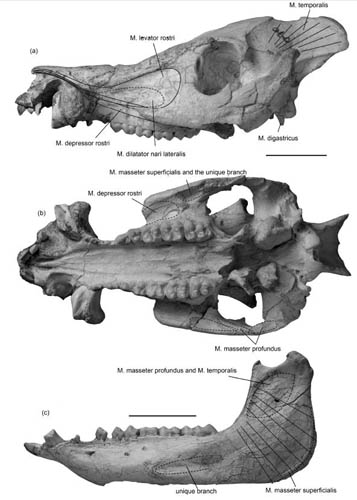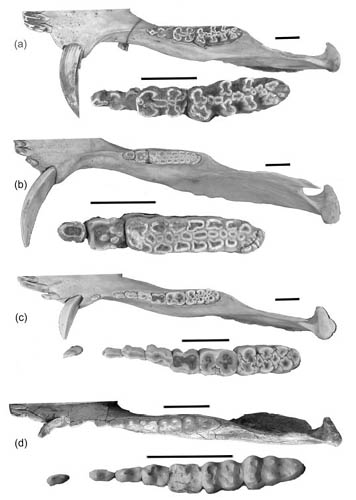Functional Analysis Reveals Miocene Fossil Pig’s Foraging Behavior
Foraging behavior and adaptations for feeding in the context of habitat condition have been studied widely in living suids (pigs) but rarely in their fossil relatives. A study published in Science China: Earth Sciences (5) compared the skull and mandible of a Late Miocene fossil pig from the Linxia Basin, Gansu Province, China, Chleuastochoerus, with those of extant pigs and peccaries, and revealed the foraging behavior of Chleuastochoerus, adding fresh evidence that the area of the Linxia Basin was open but still relatively humid in the middle-late Late Miocene.
Chleuastochoerus is a small Asian endemic Late Miocene fossil pig, and its geographic range may be limited to northern China and the southwestern part of Asiatic Russia. In recent years, abundant specimens of Chleuastochoerus have been found in the Linxia Basin, Gansu Province, China. These new finds have included skulls and mandibles of juveniles and adult males and females, and even a nearly complete skeleton. These new specimens provide an opportunity for more detailed studies of the genus.
The skull of Chleuastochoerus is less elongated than in extant suids, and its dorsal profile has only a slight posterodorsal inclination unlike in extant suids and tayassuids (peccaries). “The presence of a rostral bone in the skull and relatively strong rostral muscles indicates that Chleuastochoerus possessed considerable digging ability, though the relatively narrow occipital surface and the shortness of the skull would have restricted the range of motion through which the skull could be swung”, said lead author Dr. HOU Sukuan, Institute of Vertebrate Paleontology and Paleoanthropology of the Chinese Academy of Sciences (IVPP), “The distinctive pre-zygomatic plate and over-canine arch-niche may have played a role in protecting the skull and canines during digging”.
The massive masticatory muscles of Chleuastochoerus, reconstructed based on well-developed parietal and zygomatic crests, would have enabled the mouth to close quickly and contributed to moving the mandible both longitudinally and laterally. The configuration of the cranio-mandibular joint and its relatively high position show clearly that Chleuastochoerus was capable of both crushing and grinding movements during mastication.
The dentition of Chleuastochoerus is generally Sus-like, but simpler and more primitive. The incisors of Chleuastochoerus are clearly primitive. The comparatively simple structure of the crown surfaces of the cheek teeth suggests that the food of Chleuastochoerus may have been softer than that of extant suids. The diet of Chleuastochoerus may have been intermediate in composition between those of true forest suids (Sus, Potamochoerus) and open habitat suids (Hylochoerus, Phacochoerus) today, perhaps most closely resembling that of the savannah-adapted Potamochoerus, and the habitat of Chleuastochoerus should be relatively humid forest edge or nearby areas of open steppe.
This work was supported by National Natural Science Foundation of China, Chinese Academy of Sciences, Ministry of Science and Technology of China, and Key Deployment Project of Institute of Vertebrate Paleontology and Paleoanthropology, Chinese Academy of Sciences.

Fig.1 Rostral and masticatory muscles of Chleuastochoerus. (a) lateral view of skull; (b) ventral view of skull; (c) lateral view of mandible. Scale bars equal 5 cm.

Fig.2 Left mandibles of Hylochoerus (a), Phacochoerus (b), Sus (c), and Chleuastochoerus (d) in occlusal view. Scale bars equal 3 cm.
Download attachments: